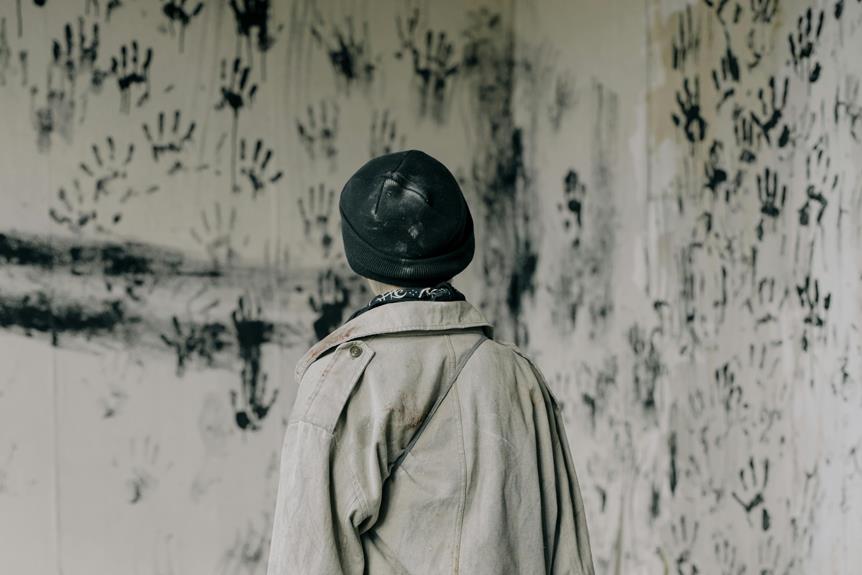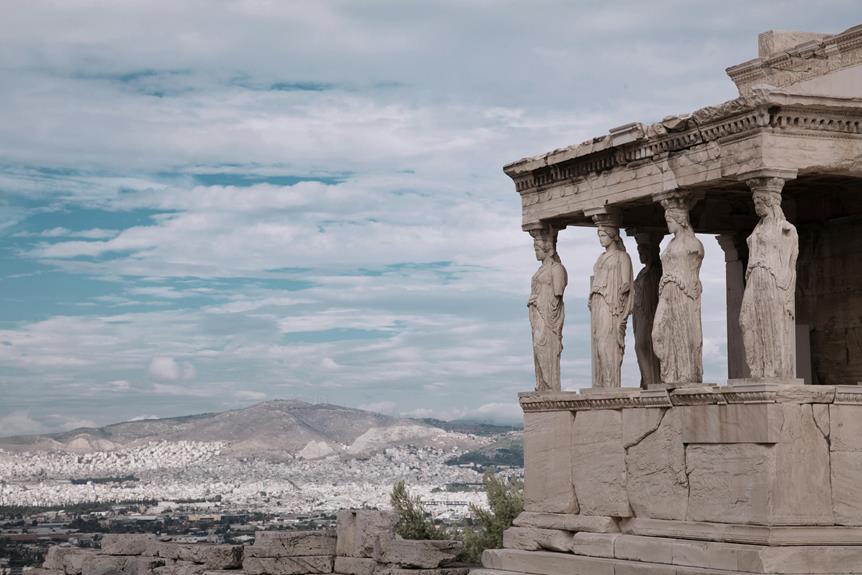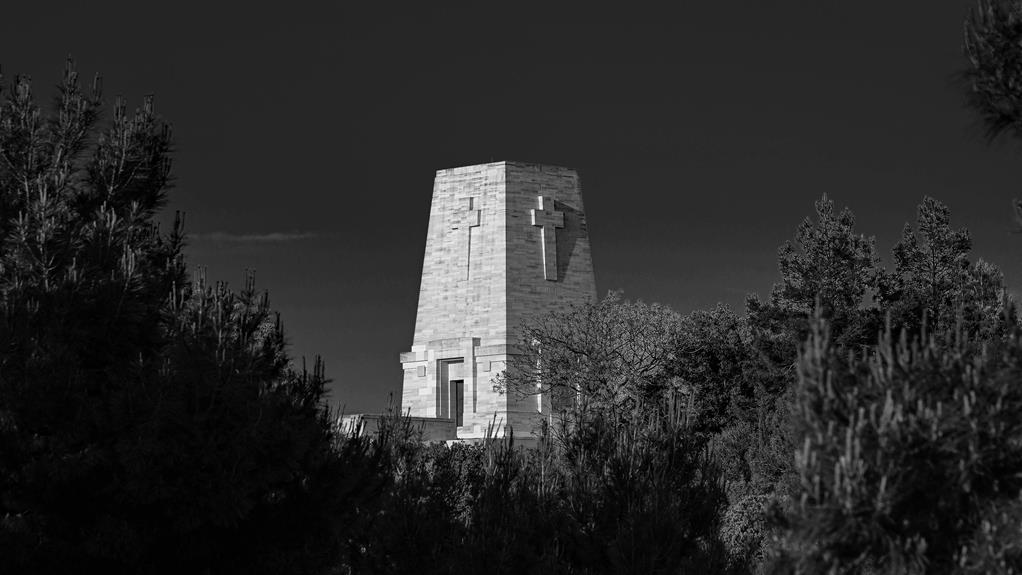The Hurricane Katrina Memorial in the USA serves as a solemn tribute to a catastrophic event that left an indelible mark on the nation. Its design and symbolism not only honor the lives lost but also embody the resilience and strength of the human spirit. As visitors walk through the memorial, they are confronted with powerful reminders of the past and are encouraged to reflect on the lessons learned from this tragedy. The memorial's significance goes beyond mere remembrance, prompting contemplation on how communities can come together in times of crisis.
Key Takeaways
- Innovative design blending modern and traditional styles.
- Symbolic elements like Broken Levee and Phoenix Sculpture.
- Guided tours for insight into significance and design.
- Reflective features like tranquil pool and memorial gardens.
- Annual remembrance ceremony honoring lives lost.
History of Hurricane Katrina
The history of Hurricane Katrina traces back to August 23, 2005, when the storm emerged as a tropical depression over the Bahamas. As it moved west across the Gulf of Mexico, Katrina rapidly intensified into a Category 5 hurricane, with sustained winds reaching 175 mph. The causes of such a devastating storm were a combination of warm sea surface temperatures, high humidity, and low wind shear, providing the ideal conditions for its development into a powerful hurricane.
On August 29, 2005, Hurricane Katrina made landfall in Louisiana, resulting in catastrophic damage along the Gulf Coast. The aftermath of the storm was marked by severe flooding in New Orleans when the levee system failed, leading to approximately 80% of the city being submerged. The devastation caused by Katrina resulted in over 1,800 fatalities and billions of dollars in property damage, making it one of the deadliest and costliest hurricanes in U.S. history.
The aftermath of Hurricane Katrina prompted significant changes in disaster preparedness and response protocols. The inadequacies in the government's response sparked a national debate on emergency management and highlighted the importance of improving infrastructure to withstand future natural disasters. The lessons learned from Katrina continue to shape emergency planning efforts to mitigate the impact of future catastrophic events.
Impact on New Orleans
Following Hurricane Katrina's landfall in Louisiana, New Orleans experienced widespread devastation, primarily due to the failure of the levee system and subsequent catastrophic flooding. The impact on New Orleans was profound, affecting the city in various ways:
- Loss of Lives: The storm caused the tragic loss of over 1,800 lives in the New Orleans area, leaving families shattered and communities grieving.
- Destroyed Infrastructure: Homes, businesses, and critical infrastructure were ravaged, leaving many residents displaced and without basic necessities.
- Economic Disruption: The city's economy took a severe hit, with businesses closing, jobs lost, and a long road to recovery ahead.
- Emotional Trauma: The psychological toll on residents was immense, as many grappled with trauma, loss, and uncertainty about the future.
- Environmental Impact: The hurricane and subsequent flooding caused significant environmental damage, affecting ecosystems, water quality, and wildlife habitats in the region.
In the aftermath of the disaster, New Orleans initiated extensive rebuilding efforts to restore the city and revitalize its communities. These initiatives aimed not only to reconstruct physical structures but also to uplift the spirits of the resilient population. The environmental impact spurred measures to safeguard against future disasters and preserve the delicate ecosystem of the region. The city's journey toward recovery serves as a tribute to the strength and determination of its people in the face of adversity.
Design and Architecture
Amidst the aftermath of Hurricane Katrina in New Orleans, how did the design and architecture respond to the challenges posed by the devastating natural disaster? The design and architecture of the Hurricane Katrina Memorial in New Orleans stand as a demonstration of design innovation and architectural significance in the face of tragedy.
After the catastrophic impact of Hurricane Katrina, architects and designers were tasked with creating a memorial that could honor the lives lost, the resilience of the community, and the enduring spirit of New Orleans. The design of the memorial incorporates elements that pay homage to the history of the city while also looking towards the future with hope and strength.
In terms of design innovation, the memorial features sustainable materials and construction techniques that not only reduce its environmental impact but also serve as a symbol of renewal and regeneration. The architecture of the memorial blends modern aesthetics with traditional New Orleans styles, creating a space that is both visually striking and emotionally resonant.
The architectural significance of the memorial lies in its ability to evoke a sense of healing and remembrance, providing a place for visitors to reflect, mourn, and find solace. Through thoughtful design and careful attention to detail, the Hurricane Katrina Memorial stands as a poignant reminder of the resilience of the human spirit in the face of adversity.
Symbolism in the Memorial
In the memorial dedicated to Hurricane Katrina, the symbolism embedded within the design and architecture serves as a powerful affirmation of the enduring legacy of the disaster and the resilience of the community it impacted.
- The Broken Levee: A representation of the breached levees that led to catastrophic flooding, symbolizing the vulnerability of human structures in the face of nature's fury.
- The Tree of Resilience: A solitary tree standing tall amidst the destruction, signifying hope, renewal, and the strength to endure even in the harshest conditions.
- The Flowing Water Feature: Reflecting the unstoppable force of the floodwaters, serving as a reminder of the destructive power of natural disasters and the need for unity in rebuilding.
- The Wall of Names: Engraved with the names of those who lost their lives, a solemn tribute to the individuals who perished, ensuring they are forever remembered and honored.
- The Phoenix Sculpture: Rising from the ashes, symbolizing the rebirth and regeneration of the community, a beacon of resilience and the promise of a brighter future.
These symbolic elements intertwine to create a poignant narrative of remembrance, paying homage to the past while inspiring hope for the future. Each aspect of the memorial encapsulates the spirit of unity and resilience in the face of adversity, inviting visitors to reflect on the enduring impact of Hurricane Katrina and the strength of the human spirit in times of crisis.
Visitor Experience and Tours
Improving the understanding and appreciation of the memorial, guided tours offer visitors a thorough insight into the significance and design elements of the Hurricane Katrina Memorial in the USA. These tours provide an interactive experience, allowing visitors to engage with the memorial's history and impact in a more meaningful way.
Guided tours at the Hurricane Katrina Memorial often include knowledgeable guides who share detailed information about the memorial's design, the symbolism behind its various elements, and the historical context of the devastating hurricane. Visitors have the opportunity to ask questions, further enriching their understanding of the memorial.
Interactive exhibits are also a key feature of the visitor experience at the memorial. These exhibits may include multimedia displays, artifacts from the hurricane, and personal stories from survivors and volunteers. By engaging with these interactive elements, visitors can gain a deeper appreciation for the resilience of the communities affected by Hurricane Katrina and the importance of remembering this tragic event.
Commemorating the Lives Lost
With solemn reverence, the Hurricane Katrina Memorial in the USA stands as a poignant tribute to the lives lost during the catastrophic event. The memorial serves as a place for reflection and remembrance, honoring the individuals who tragically perished during the hurricane and its aftermath.
- Inscription Wall: Etched with the names of the deceased, the inscription wall stands as a solemn reminder of the lives lost, allowing visitors to pay their respects and remember each individual.
- Eternal Flame: The flickering flame symbolizes the enduring spirit of those who lost their lives, providing a sense of comfort and hope amidst the tragedy.
- Reflecting Pool: The tranquil waters of the reflecting pool offer a space for contemplation and meditation, creating a serene atmosphere for visitors to remember the victims.
- Memorial Gardens: Lush gardens surrounding the memorial provide a peaceful setting for visitors to wander, offering a place of solace and reflection in nature.
- Annual Remembrance Ceremony: Each year, a remembrance ceremony is held at the memorial to honor the lives lost, bringing the community together in solidarity and support.
These elements combine to create a place of solace and remembrance, ensuring that the memories of those who perished in Hurricane Katrina will never be forgotten.
Community Healing and Resilience
Community solidarity emerges as a cornerstone in fostering healing and resilience in the aftermath of the Hurricane Katrina tragedy. Following the devastation caused by the hurricane, various healing initiatives were implemented to support the affected communities. Resilience workshops played a significant role in providing individuals with the tools and strategies needed to cope with trauma and rebuild their lives.
These resilience workshops focused on equipping community members with skills such as stress management, effective communication, and problem-solving. By empowering individuals with these resources, the workshops aimed to enhance their ability to navigate the challenges brought about by the disaster and ultimately foster a sense of resilience within the community.
In addition to resilience workshops, healing initiatives were also instrumental in promoting community healing and unity. These initiatives encompassed a range of activities, including group therapy sessions, art therapy, and community support groups. Through these programs, individuals were able to express their emotions, connect with others who shared similar experiences, and work towards collectively healing from the trauma of Hurricane Katrina.
Educational Programs and Outreach
In the aftermath of Hurricane Katrina, educational programs and outreach initiatives were implemented to provide knowledge and support to the affected communities. These initiatives aimed to empower individuals with the necessary information and resources to rebuild their lives and communities. The educational programs and outreach efforts played a pivotal role in fostering resilience and promoting recovery among those impacted by the disaster.
- Community Workshops: Educational workshops were organized to educate community members on disaster preparedness, response strategies, and post-disaster recovery resources.
- School Programs: Schools in the affected areas integrated trauma-informed educational resources and programs into their curriculum to support students in coping with the aftermath of the hurricane.
- Mental Health Support: Outreach initiatives included mental health awareness campaigns and counseling services to address the psychological impact of the disaster on individuals and families.
- Skill-Building Programs: Vocational training programs were offered to help community members develop new skills and enhance their employability in the post-Katrina job market.
- Resource Fairs: Community resource fairs were organized to connect residents with educational resources, job opportunities, housing assistance, and other essential services crucial for their recovery journey.
Through these educational programs and outreach initiatives, the affected communities were provided with the necessary tools and knowledge to navigate the challenges brought about by Hurricane Katrina and rebuild a stronger, more resilient future.
Support and Donations
Following the implementation of educational programs and outreach initiatives, the next essential aspect to address is the facilitation of support and donations for the communities affected by Hurricane Katrina. In times of crisis, the generosity of individuals and organizations through donations drives and volunteer opportunities plays a pivotal role in rebuilding and supporting the affected areas. Below is a table highlighting ways individuals can contribute to the cause:
| Type of Support | Description |
|---|---|
| Monetary Donations | Financial contributions to reputable organizations aiding in the recovery efforts. |
| In-Kind Donations | Donation of goods such as non-perishable food, clothing, and hygiene products. |
| Volunteer Opportunities | Hands-on involvement in rebuilding projects, community clean-ups, and support services. |
| Fundraising Events | Organizing or participating in events to raise funds for hurricane survivors and affected communities. |
Engaging in these forms of support not only provides tangible assistance but also fosters a sense of community and solidarity among those impacted by the hurricane. By participating in donations drives and volunteer opportunities, individuals can make a meaningful difference in the lives of those working to recover and rebuild after the devastation of Hurricane Katrina.
Future of the Memorial
An integral consideration for the Hurricane Katrina Memorial's future is the strategic planning of sustainable maintenance and preservation efforts to guarantee its longevity and significance. Ensuring the memorial's continued existence and relevance will require addressing funding challenges and establishing robust sustainability practices. Public engagement will play a vital role in shaping the future of the memorial, fostering community involvement and support for upcoming events.
- Preserving Memories: Honoring the stories and lives lost during Hurricane Katrina through ongoing educational programs and exhibits.
- Renewing Hope: Creating spaces for reflection and healing, offering solace to those affected by the disaster.
- Building Resilience: Inspiring future generations to learn from the past and work towards a more resilient future.
- Celebrating Unity: Bringing people together to commemorate the strength and solidarity shown in times of crisis.
- Ensuring Legacy: Establishing partnerships and collaborations to secure the memorial's legacy for years to come.
Frequently Asked Questions
Are Pets Allowed at the Hurricane Katrina Memorial?
Pet restrictions are common at memorial sites due to the need for a solemn and respectful atmosphere.
Emotional support animals may be allowed in certain cases, but it is advisable to check with the specific memorial's policies beforehand.
It is important to adhere to any regulations in place to guarantee the peaceful experience of all visitors.
Is There a Time Limit for Visiting the Memorial?
There is no specified time limit for visiting the memorial. Visitors can explore the site at their own pace.
Parking availability is typically provided for visitors, though it may vary based on demand.
Guided tours may be available for those who prefer a structured experience.
It is advisable to check for any updates or changes in operating hours or accessibility before planning a visit to the memorial.
Can Visitors Leave Personal Mementos at the Memorial?
Visitors often seek ways to honor loved ones at memorials by leaving personal mementos such as floral tributes or art installations. This practice allows individuals to express their emotions and pay respects in a tangible way.
While guidelines may vary, many memorials permit the placement of these items as a way to foster a sense of connection and remembrance among visitors.
Are There Any Special Events Held at the Memorial?
Memorial ceremonies are often organized at the site to honor and remember the individuals affected by the tragedy. These events provide an opportunity for the community to come together in remembrance.
Additionally, volunteer opportunities may be available for those interested in contributing to the upkeep and maintenance of the memorial. These activities offer a chance for individuals to participate in meaningful ways and support the memorial's mission of remembrance and reflection.
Is the Memorial Wheelchair Accessible?
Accessibility features play an essential role in ensuring inclusivity and equal access to public spaces. Efforts to enhance wheelchair accessibility at various sites contribute to a more inclusive environment for all individuals.
Implementing ramps, elevators, and designated parking spaces are some common accessibility features that are essential for accommodating individuals with mobility challenges. Inclusion efforts through such features promote diversity and equal opportunities for all visitors to enjoy public spaces.
Conclusion
To sum up, the Hurricane Katrina Memorial in the USA stands as a powerful symbol of remembrance, healing, and resilience in the face of tragedy. Its innovative design and symbolic elements serve as a poignant reminder of the impact of one of the deadliest hurricanes in American history.
As visitors reflect on the stories of those affected by the devastation, the memorial continues to inspire hope and honor the lives lost, ensuring that their legacy lives on.


